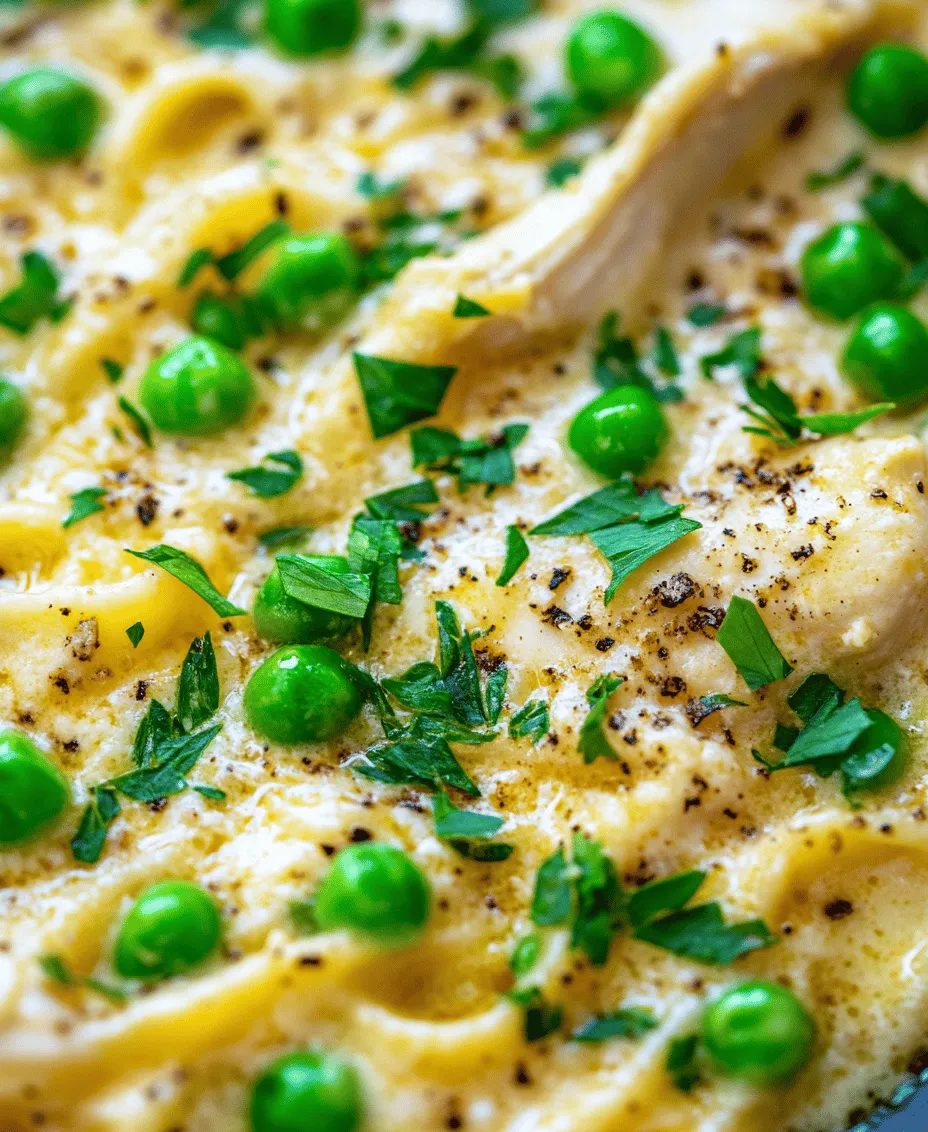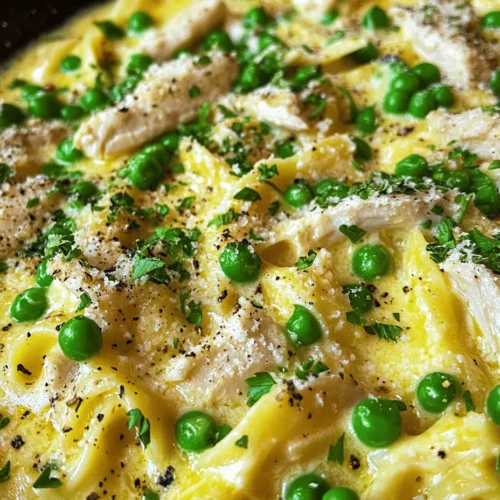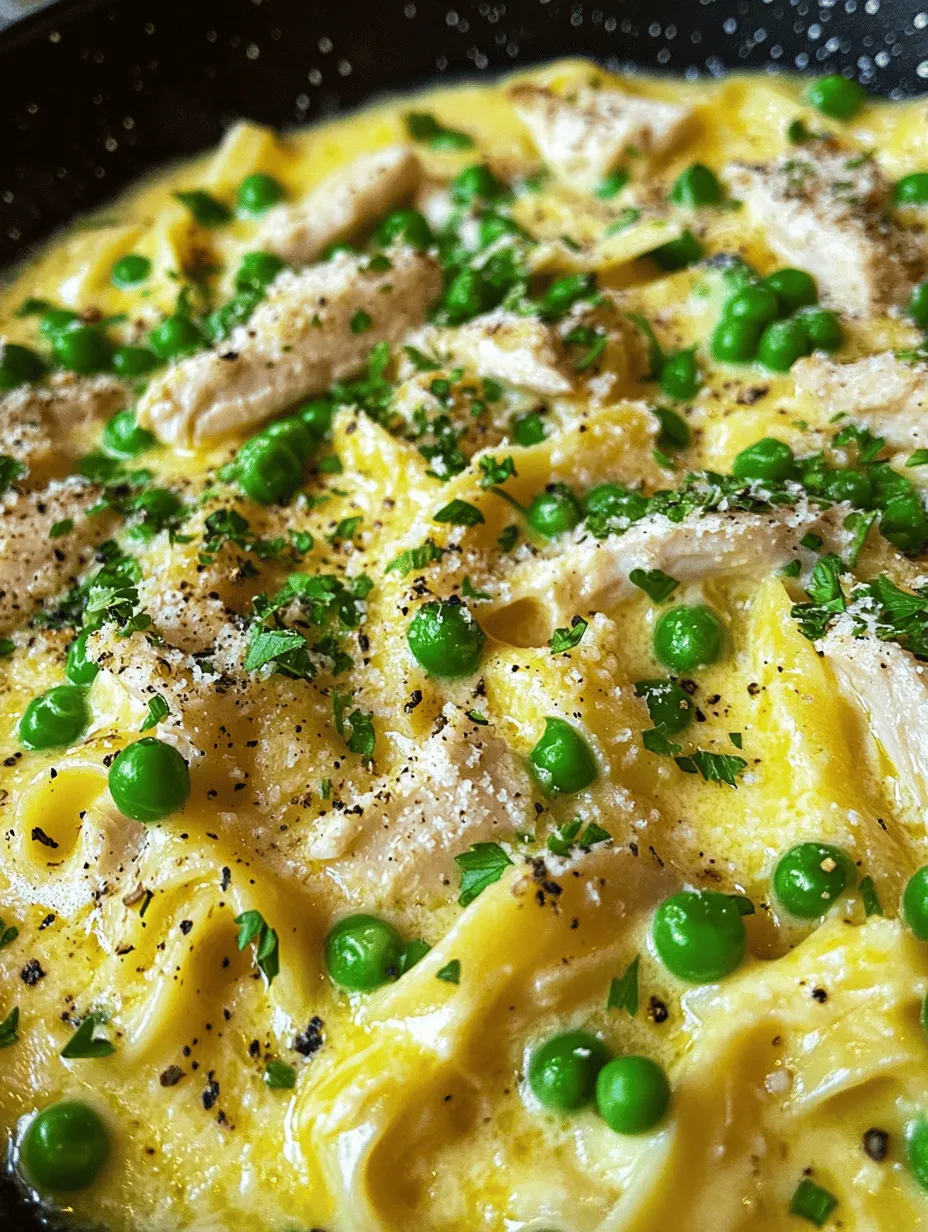Introduction
Chicken Carbonara is a beloved classic that originates from Italy, renowned for its creamy texture, rich flavors, and comforting qualities. This dish has captured the hearts of food enthusiasts worldwide, offering a delightful combination of simple ingredients that come together to create a satisfying meal. The appeal of Chicken Carbonara lies not only in its indulgent taste but also in its versatility—making it an ideal choice for both casual weeknight dinners and special occasions.
As a variation of the traditional Roman Carbonara, which typically combines guanciale (cured pork cheek), eggs, cheese, and pepper, Chicken Carbonara introduces tender chicken breasts into the mix. This adaptation appeals to those looking for a dish that is both satisfying and easy to prepare, while still retaining the essence of Italian cooking. Its creamy sauce and hearty pasta create a dish that is as comforting as it is delicious, perfect for any pasta lover.
In this article, we will explore the nuances of Chicken Carbonara, its historical background, the essential ingredients that contribute to its signature flavor, and a step-by-step guide to preparing this delectable meal.
Understanding Chicken Carbonara
To truly appreciate Chicken Carbonara, it’s essential to understand its roots. The origins of Carbonara date back to the mid-20th century in Rome, where it is said to have been created by Italian charcoal workers, or “carbonai.” The dish was originally made with simple ingredients that were easy to carry and cook over a campfire, including pasta, eggs, cured pork, and cheese. The creamy sauce was formed by combining the eggs with the residual heat of the pasta, creating a rich, velvety texture without the use of cream.
While traditional Carbonara remains a staple in Italian cuisine, Chicken Carbonara has gained popularity for its approachable nature and the addition of lean protein. In this version, the chicken adds a new dimension to the recipe, making it a more filling option while preserving the classic flavors. The creamy sauce still features the key elements of the original dish, ensuring that each bite is a delightful blend of savory and satisfying.
The Role of Each Ingredient in Building Flavor and Texture
Every ingredient in Chicken Carbonara plays a crucial role in achieving the dish’s signature flavor and texture. Here’s a breakdown of the essential components:
1. Pasta: The foundation of the dish, spaghetti or fettuccine are the best pasta options for Carbonara, providing a perfect vehicle for the creamy sauce.
2. Olive Oil: Quality matters when it comes to olive oil. It not only adds flavor but also helps in cooking the chicken, ensuring it remains juicy and tender.
3. Chicken Breasts: The choice of chicken is vital. Opting for boneless, skinless chicken breasts provides lean protein that complements the rich sauce without overwhelming it.
4. Eggs: Eggs are the heart of the Carbonara sauce. They create a creamy emulsion when combined with the hot pasta, lending the dish its characteristic smoothness.
5. Parmesan Cheese: Freshly grated Parmesan cheese adds depth and complexity to the sauce. It melts beautifully, enhancing the creaminess and flavor profile.
6. Heavy Cream: While traditional Carbonara does not include cream, many modern recipes, including Chicken Carbonara, use it to enhance richness and provide a luxurious texture.
7. Garlic: A key aromatic, garlic elevates the flavor of the chicken and adds a fragrant note to the overall dish.
8. Peas: Peas contribute a pop of color and sweetness, along with added nutrition, making the dish visually appealing and well-rounded.
9. Fresh Parsley and Black Pepper: These finishing touches add brightness and a hint of heat, balancing the richness of the sauce and enhancing the dish’s overall flavor.
Essential Ingredients for Chicken Carbonara
Spaghetti or Fettuccine
The choice of pasta is crucial in any Carbonara dish. For Chicken Carbonara, spaghetti and fettuccine are the most commonly used types. Spaghetti, with its long, thin strands, clings well to the creamy sauce, while fettuccine, being flat and wide, offers a hearty bite that complements the richness of the dish. When cooking pasta, it’s essential to aim for an al dente texture, which provides a slight firmness that holds up well in the sauce.
Olive Oil
The importance of quality olive oil cannot be overstated. Using extra virgin olive oil enhances the flavors of the dish and adds a fruity, peppery note that beautifully complements the chicken. When sautéing the chicken, the olive oil helps to achieve a golden-brown crust, sealing in moisture and flavor.
Chicken Breasts
When selecting chicken for this recipe, boneless, skinless chicken breasts are the best choice. They are lean, cook quickly, and absorb the flavors of the sauce beautifully. Before cooking, it’s recommended to season the chicken generously with salt and pepper to enhance its natural flavor. Cutting the chicken into bite-sized pieces ensures even cooking and allows for better incorporation into the pasta.
Eggs
The eggs in Chicken Carbonara serve as the backbone of the creamy sauce. When combined with the hot pasta, the residual heat cooks the eggs gently, creating a silky sauce without scrambling the eggs. It is advisable to use fresh, high-quality eggs for the best flavor and texture.
Parmesan Cheese
Freshly grated Parmesan cheese is a must for this recipe. While pre-grated cheese may be convenient, it often contains anti-caking agents that can affect its melting quality. Freshly grating the cheese ensures a smooth incorporation into the sauce, resulting in a richer and more flavorful dish.
Heavy Cream
While classic Carbonara relies solely on eggs for creaminess, the addition of heavy cream in Chicken Carbonara elevates the dish to a new level of indulgence. The cream enhances the richness and provides a luxurious mouthfeel, making the dish even more comforting.
Garlic
Garlic is a key aromatic that adds depth to the flavor profile of Chicken Carbonara. Sautéing minced garlic in olive oil releases its fragrant oils, infusing the chicken with a savory aroma that enhances the overall dish.
Peas
Adding peas to Chicken Carbonara not only contributes vibrant color but also adds a touch of sweetness and nutrition. They offer a pleasant bite and a fresh contrast to the rich sauce, making each mouthful more interesting.
Fresh Parsley and Black Pepper
Finally, fresh parsley and cracked black pepper serve as finishing touches that elevate the dish. Chopped parsley adds a burst of freshness, while black pepper provides a subtle heat that balances the creaminess of the sauce. These garnishes not only enhance the visual appeal but also round out the flavors, creating a harmonious dish.
Step-by-Step Instructions for Preparing Chicken Carbonara
Cooking the Pasta
The first step to creating the perfect Chicken Carbonara is cooking the pasta. Begin by bringing a large pot of salted water to a rolling boil. The salt is crucial as it seasons the pasta while it cooks. Add the spaghetti or fettuccine and cook according to the package instructions until al dente. Remember to reserve about a cup of the pasta water before draining, as this starchy liquid can be added to the sauce later to achieve the desired consistency.
Preparing the Chicken
While the pasta is cooking, it’s time to prepare the chicken. Start by cutting the boneless, skinless chicken breasts into bite-sized pieces. Season generously with salt and pepper to enhance the flavor. Heat a couple of tablespoons of olive oil in a large skillet over medium heat. Once the oil is shimmering, add the seasoned chicken to the skillet in a single layer. This ensures even cooking and helps achieve a nice golden-brown crust. Cook the chicken for about 6-8 minutes, stirring occasionally, until it is cooked through and no longer pink in the center. Once cooked, remove the chicken from the skillet and set it aside, allowing it to rest while you prepare the sauce.
By following these initial steps, you set the foundation for a delicious Chicken Carbonara that will impress both family and friends. In the next installment, we will delve deeper into combining these elements to create the creamy sauce and complete the dish. Stay tuned for the continuation of this culinary adventure!

Creating the Carbonara Sauce: Techniques for Achieving the Perfect Creamy Consistency
The essence of a great Chicken Carbonara lies in its creamy sauce, which is traditionally made without cream. Instead, the velvety texture comes from the emulsification of beaten eggs with the rendered fat from the pancetta or bacon, combined with the starchy pasta water. To achieve this perfect creamy consistency, start by whisking together the eggs and grated cheese in a bowl until thoroughly combined. The warmth from the pasta will gently cook the eggs, resulting in a luxurious sauce that clings beautifully to the noodles.
To ensure that you achieve a smooth sauce, it’s crucial to work quickly once the pasta is cooked. After draining the pasta, reserve some of the cooking water, and then immediately transfer the hot pasta to the bowl with the egg and cheese mixture. Toss vigorously while adding small amounts of the reserved pasta water. This step helps to create a silky sauce, as the heat from the pasta cooks the eggs without scrambling them, while the starchy water contributes to the desired consistency.
Sautéing Aromatics: The Significance of Garlic in the Flavor Profile
Garlic plays a pivotal role in elevating the flavor profile of Chicken Carbonara. When sautéed, garlic releases its essential oils, infusing the dish with a rich, aromatic quality that complements the savory elements of the pancetta and chicken. Begin by heating olive oil or butter in a large skillet over medium heat. Once hot, add minced garlic and sauté until fragrant, which should take about 30 seconds to a minute. Be careful not to let it brown too much, as burnt garlic can impart a bitter taste.
Once the garlic is fragrant, add the pancetta or bacon to the skillet, allowing it to crisp up and render its fat. This combination of garlic and pork creates a base of flavor that is both comforting and indulgent, setting the stage for the entire dish. As the meat cooks, it will absorb the garlic’s essence, enhancing the overall depth of flavor in the final dish.
Combining Ingredients: Tips for Uniformly Mixing the Sauce with Pasta
To ensure that your Chicken Carbonara is a harmonious blend of flavors and textures, proper mixing is essential. After sautéing the garlic and pancetta, add the cooked pasta directly to the skillet, tossing it with the garlic and pancetta to coat the noodles evenly in the rendered fat. This step is crucial, as it allows the pasta to absorb the flavors before the sauce is added.
Once the pasta is well-coated, it’s time to incorporate the creamy sauce. Remove the skillet from the heat to prevent the eggs from scrambling. Pour the egg and cheese mixture over the hot pasta and quickly toss everything together. It’s important to work swiftly here; the residual heat from the pasta will cook the eggs gently, resulting in a creamy sauce. If the sauce appears too thick, gradually add reserved pasta water until you reach the desired consistency. This technique not only ensures a creamy Carbonara but also prevents clumping, allowing each strand of pasta to be perfectly coated.
Final Touches: How to Serve and Garnish Beautifully for Presentation
Presentation can elevate your Chicken Carbonara from a comforting meal to a stunning dish worthy of a dinner party. Start by serving the pasta in warm bowls or plates to maintain its temperature. For an eye-catching presentation, twirl the pasta using a fork and spoon to create a nest-like shape in the center of the plate.
After plating, garnish generously with freshly grated Parmesan cheese, a sprinkle of black pepper, and chopped parsley for a touch of color and freshness. For an added layer of flavor, consider drizzling a little extra virgin olive oil over the top. This not only enhances the visual appeal but also adds richness to each bite. Serve immediately, allowing your guests to enjoy the dish while it’s hot and creamy.
Nutritional Breakdown of Chicken Carbonara
When you indulge in a delicious plate of Chicken Carbonara, you may be curious about its nutritional content. A typical serving of Chicken Carbonara contains approximately 600-700 calories, depending on the specific ingredients and portion sizes. It generally consists of around 30-40 grams of protein, 25-30 grams of fat, and 60-70 grams of carbohydrates.
The chicken in the dish serves as a lean protein source, while the egg yolks contribute healthy fats and additional protein. Peas, often included in the recipe, add fiber, vitamins, and minerals, making the dish more nutritious. To create a balanced meal, consider serving your Chicken Carbonara with a side salad filled with colorful vegetables, which can add additional fiber and nutrients to your plate.
Variations and Customizations
One of the best aspects of Chicken Carbonara is its versatility, allowing for various adaptations to suit dietary preferences or to incorporate seasonal ingredients. If you’re looking for alternative pasta options, consider using gluten-free pasta or whole wheat pasta to boost the fiber content. These options cater to those with gluten sensitivities or those seeking healthier carbohydrate choices.
Protein substitutions are another way to customize this dish. Ground turkey or shrimp can replace chicken for a different flavor profile, while tofu can serve as a vegetarian alternative. For a vegetarian adaptation, simply omit the chicken and add a medley of seasonal vegetables, such as zucchini, spinach, or bell peppers.
For those who enjoy culinary creativity, consider adding sun-dried tomatoes or sautéed mushrooms for an earthy twist. These ingredients can add depth and complexity to the dish, transforming the classic Carbonara into something uniquely yours.
Common Mistakes to Avoid When Making Chicken Carbonara
While Chicken Carbonara is a straightforward dish, a few common pitfalls can detract from your final product. Overcooking the pasta is a frequent mistake; ensure that you cook the pasta just until al dente, as it will continue to cook slightly when mixed with the sauce.
Another critical aspect is the temperature at which you combine the sauce ingredients. Adding the egg mixture to the pasta while the skillet is still over heat can lead to scrambled eggs rather than a creamy sauce. Always remove the pan from the heat before introducing the egg mixture.
Finding the right balance of creaminess is essential; using too much cream can result in a heavy dish. Remember, the goal of Carbonara is to achieve a delicate, silky sauce using the egg and cheese mixture. Lastly, don’t neglect seasoning; a generous pinch of salt and freshly cracked pepper can elevate the flavors, making your dish more satisfying.
Conclusion
Making Chicken Carbonara at home is a delightful culinary experience that allows you to create a comforting dish with ease. This recipe not only highlights the joy of cooking but also the satisfaction of enjoying a homemade meal that feels indulgent yet approachable. The creamy sauce, the crispy pancetta, and the tender chicken come together to create a dish that is sure to please.
As you experiment with the recipe, don’t hesitate to add your unique touches, whether through different proteins, vegetables, or garnishes. Cooking is as much about creativity as it is about following a recipe, so have fun with it! Sharing this Chicken Carbonara with family and friends will undoubtedly create memorable dining experiences, reminding everyone of the comfort and love that homemade meals can bring. Enjoy your culinary journey, and savor every delicious bite!



